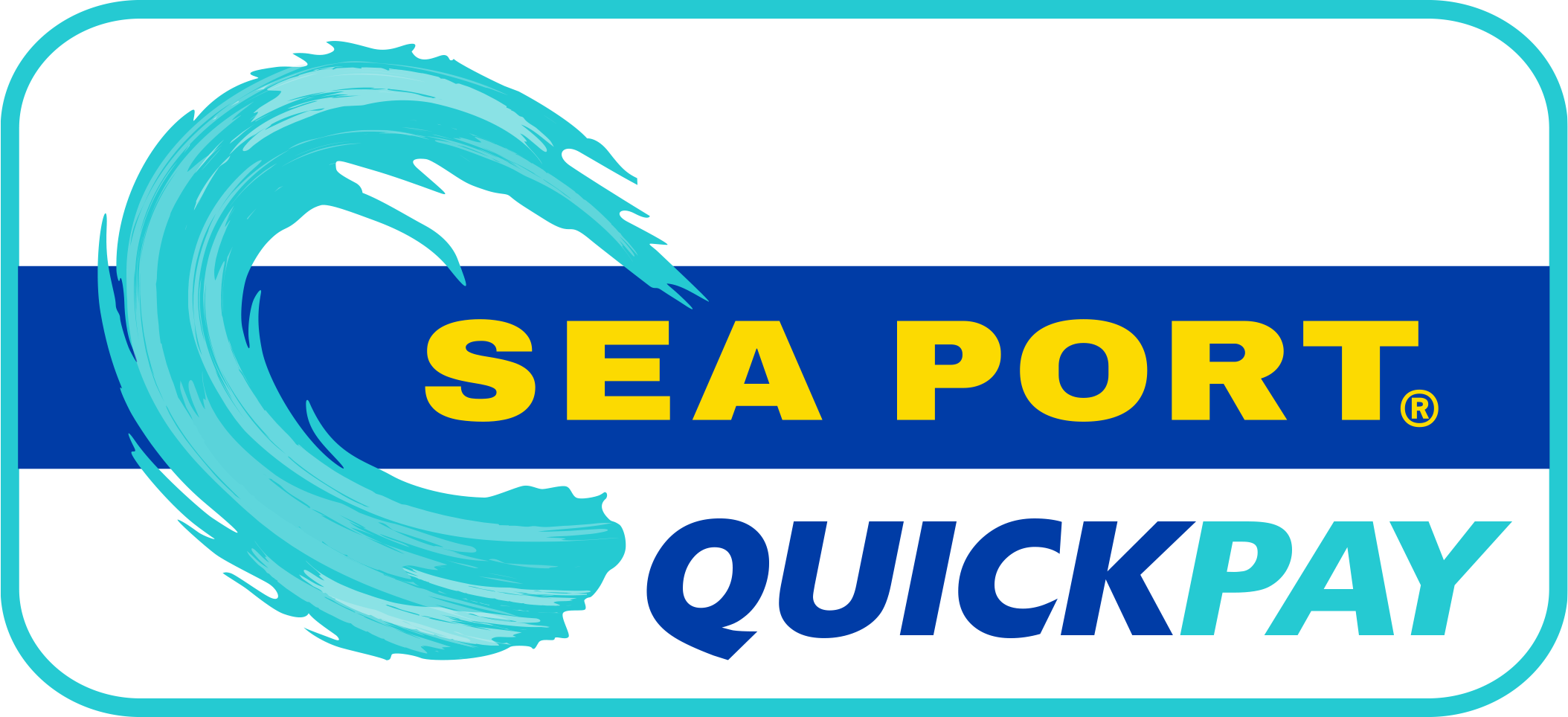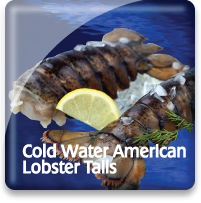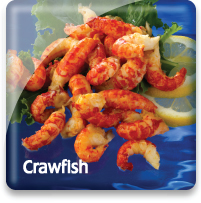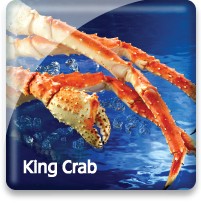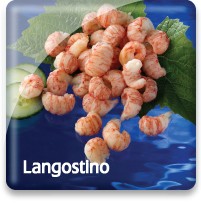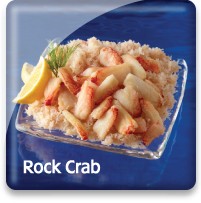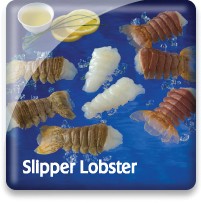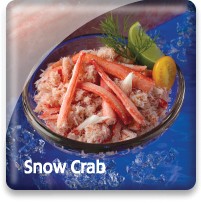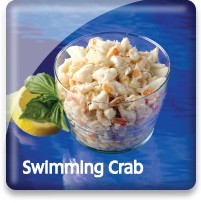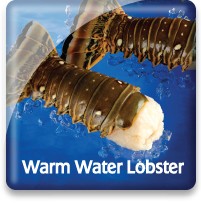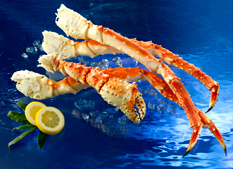
King Crab

Market Name: Eating QualitiesKing crab is a sweet flavored meat with a fibrous, string-like texture suitable for eating hot or cold.
   |
Description & CharacteristicsKing Crab are large spider crabs naturally found in the northernmost waters of the Pacific, from Alaska to northern Japan. In the 1960s Russian scientists introduced red king crab to the Barents Sea and today a sizable commercial fishery has been established. Although red king crab, Paralithodes camtschaticus, is the most well-known commercially caught king crab, both Lithodes aequispinus or golden king crab, and Paralithodes platypus or Blue King Crab, are significant species.King crabs average six to eight pounds each, but sometimes grow as large as 20 pounds. The U.S. market is supplied largely from Alaska and Russia, and more recently, a small amount has come from Norway. King crab is landed whole, immediately cooked, then split and cleaned by removing the gills and viscera and discarding the top shell. The tail shell is also separated at this stage. The remaining two pieces, which are made up of the legs and claw on one side connected by the shoulders, are called sections. These sections are the basic raw material from which all other king crab products are made. All products, therefore, are cooked before processing and freezing. Brine freezing and blast freezing are the two methods used for freezing king crab, and each method has its supporters. Brine freezing produces a moister product with salty flavor, while blast freezing may accelerate dehydration and give a less moist product. In practice, both methods give excellent results if done properly. Each crab has six walking legs, one large (“killer”) claw and one small (“feeder”) claw. Fancy legs and claws are the more common product form of king crab. Packs of legs and claws should be in the same proportions as the whole crab. Legs should be complete with both shoulder and walking tip. The size grades are based on the number of legs and claws per 10 pound. Typical grade counts are 6/9, 9/12, 12/14, 14/17, 16/20, 20/24, and 20+. These packs are normally sold in 20 pound cartons.
King crab can grow very large, with a leg span of over five feet.
Other Resources |
Handling Instructions for King Crab
Our frozen king crab legs and claws should be stored at or below 0°F (-18°C) and then thawed properly when ready to consume as a thawed precooked product. King crab legs and claws have a frozen shelf life of one year. Links to proper seafood handling instructions: NOAA - Fish Watch: Handling Seafood and A Consumer Guide to Safe Seafood Handling.
Thawing King Crab
To thaw frozen king crab legs and claws, gently rinse under cold running water to remove the thin layer of protective ice glaze and then placed them in a sealed container or plastic bag in the refrigerator (33 to 39°F) for 12-24 hours or until completely thawed. This method results in a high quality thawed crab that is immediately ready for eating cold or to use in a heated preparation. Crab that is not consumed promptly after thawing needs to be refrigerated between 33 and 39°F and consumed within 2-3 days.
Important Instructions for King Crab
Most king crab is brine frozen and this creates a salty glaze area around the cooked shell and at the exposed shoulder meat ends. Following our proper thawing recommendation as stated above gently removes this salty glaze. Consuming king crab legs and claws immediately after proper thawing yields the best quality.
The Federal Food, Drug and Cosmetic Act now requires that all foods that are not raw agricultural commodities and that contain a major food allergen be labeled to clearly identify the name of the food source form which the allergen is derived. (21 CFR U.S.C. 343(w)(1)). The act defines eight foods, and any ingredients derived from these foods as major food allergens: Fish, Crustacean Shellfish, Milk, Eggs, Tree Nuts, Peanuts, Wheat & Soybeans. The name of the food source that must be listed on the label for fish or crustacean shellfish must be the specific type of fish or crustacean shellfish. The market names of species of fish and crustacean shellfish should be used to identify the food source of these two major food allergens. If you intend to re-pack these seafood products, be sure the allergen is declared in either one of two ways:
1) Within the list of ingredients
or
2) In a separate “Contains” statement immediately after or adjacent to the list of ingredients.
Consult the Fish and Fishery Products Hazards and Controls Guidance, Fourth Edition, Chapter 19 for more detailed information on the labeling of food allergens.
Cooking Tips
King crab legs and claws are precooked and can be consumed chilled. King crab can also be used in many hot preparations. Links to cooking tips and recipes: How to Cook King Crab and Recipes.
The United States
The United States of America has over 95 thousand miles of coastline, ranks fourth in the world in wild capture fisheries and thirteenth in aquaculture production. The wild capture fisheries is dominated by Alaska pollock and followed by menhaden, salmon, flatfish, and cod. After these wild caught finfish species which comprise 84% of the entire wild catch, the remaining capture fisheries primarily consist of crab, shrimp, and shellfish. Aquaculture production in the U.S. is comprised of roughly 70% freshwater and 30% marine farms. Freshwater aquaculture is dominated by catfish and followed by trout production while the marine aquaculture in comprised of 65% shellfish (clams, oysters, & mussels), 25% salmon, and 10% shrimp. At present, aquaculture represents 5% of the total U.S. seafood production.
The long term sustainability of U.S. wild fisheries has been the goal of the 1976 Magnuson-Stevens Act. The National Marine Fisheries Service manages all activities to achieve this goal and at this time the majority of wild capture fisheries in the U.S. are sustainable. In 2011 the U.S. Department of Commerce and the National Oceanic and Atmospheric Administration released policies that promote the accelerated development of marine aquaculture. Both wild fisheries and aquaculture in the United States are currently well managed for sustainable growth.
Russia
Russia is the largest country in the world. It stretches from the Baltic Sea in the east to the Pacific Ocean and from the Arctic Ocean to the Black Sea in the South. It is nearly twice the size of the United States. The rule of law and the regulation and management of fisheries and aquaculture is weak when compared to Canada, the U.S., and other developed countries. Russia is in the top ten of the world’s fishery producers and most of this wild catch comes from the Pacific Ocean region in the areas of the Okhotsk Sea, the Bering Sea, and around the Kamchatka Peninsula. Fishery and aquaculture management is administered by the Federal Agency for Fisheries. The Russian wild fishery harvest includes over 100 commercial species of finfish and invertebrates of which pollock, herring, salmon, king crab, snow crab, and groundfish are the most important. Trout, salmon, carp, sturgeon, whitefish, and scallops are the primary items produced by Russian aquaculture. Progress improving responsible practices for both the Russian wild fisheries and the aquaculture sector has been difficult and slow. Most of the progress has been spearheaded by NGOs working with various Russian commercial fishing federations to improve the sustainability of the king crab and pollock fisheries. In September of 2013 their pollock was MSC certified as sustainable. Illegal, unreported, and unregulated (IUU) fishing is currently an ongoing problem with the poorly regulated Russian fishing industry.
Go Blue! Seafood Sustainability Spectrum*Click here for an explanation of our Sustainability Spectrum 
Sustainability AssessmentKing Crab populations in the US are well managed and assessed yearly, and the major stocks of King Crab in the US are healthy. King Crab was introduced to the Barents Sea by Russian scientists in the 1960s and 1970s, where it is now fished by Norway and Russia. King Crab presents a unique case as it is an invasive species capable of disrupting the balance in the Barents Sea ecosystem. Norway had taken steps to prevent the further spread of King Crab, but has recently begun retracting some of those efforts. Despite efforts to control populations, King Crab biomass in Norway appears to be growing.In the early days of the Barents Sea King Crab fisheries, illegal, unregulated, and unreported (IUU) fishing was widespread. Both Russia and Norway led efforts to control IUU fishing in the Barents Sea; however, it is unclear how effective these efforts have been in the King Crab fishery. The latest survey results suggest the Barents Sea King Crab resource in Russian waters is rapidly being depleted. A similar situation exists in the Russian Far East where IUU and overfishing are implicated as major factors in the decline of King Crab populations.
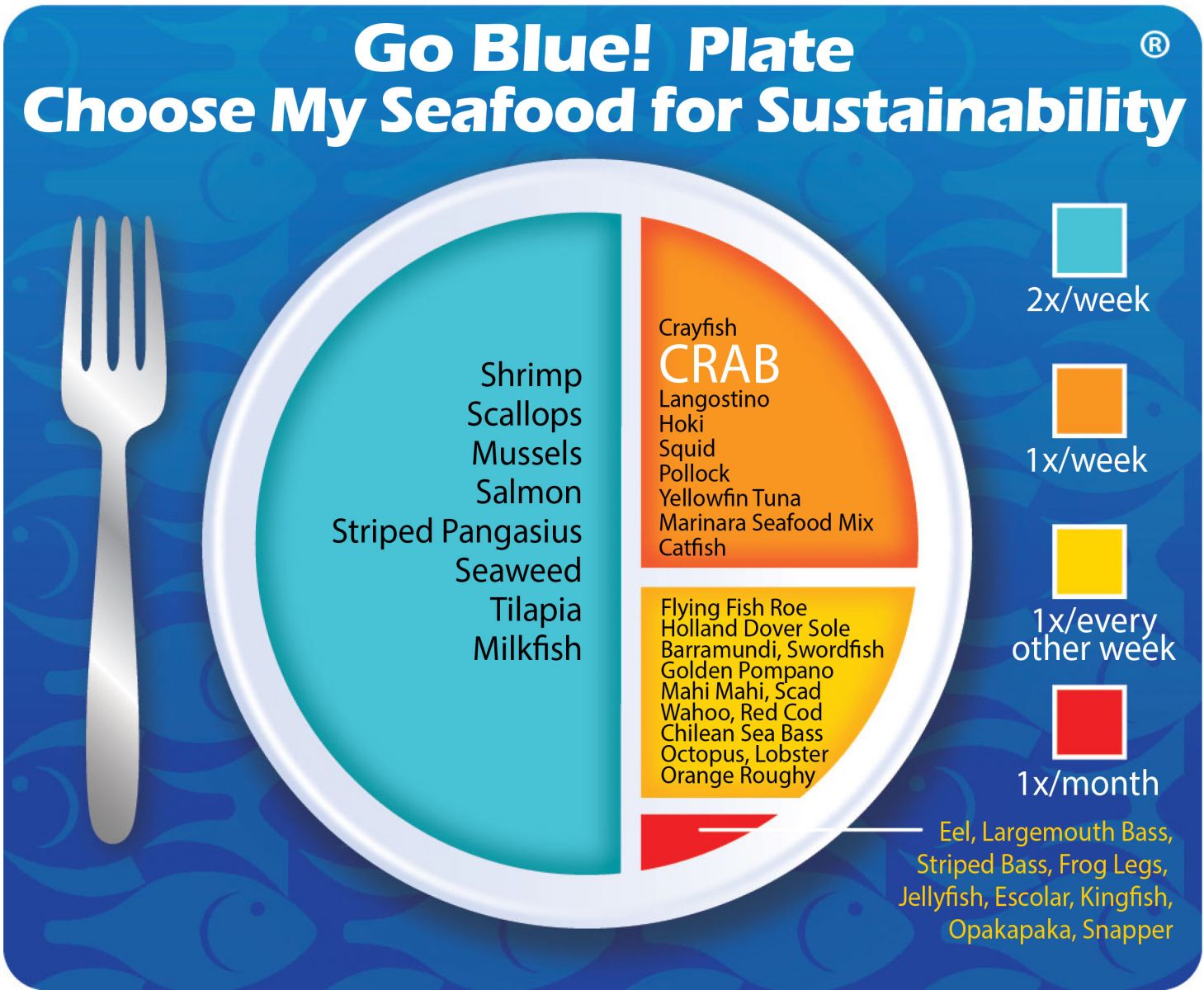
Environmental Impact: ModerateThe gear used in King Crab fisheries is relatively benign, in terms of environmental impact. The fisheries are well managed in the US. King Crab is an introduced species in the Barents Sea where it continues to present the possibility of disrupting the ecosystem. Depleted populations and IUU fishing are problematic for the Russian Far East fishery.
Sustainability Improvements NeededStudies assessing the impact of King Crab on the Barents Sea ecosystem would aid in determining how the resource should be managed. Progress to prevent IUU fishing in the Russian Far East is also needed, as IUU fishing is likely contributing to depleted populations.
Actions that Sea Port is UndertakingSea Port is continuing to source King Crab from Alaska and primarily Russia. Sea Port is seeing increased interest industry wide to improve data collection concerning illegal, unregulated, and unreported King Crab fishing in the Russian Far East and is actively looking to spur this interest forward. Sea Port is requiring that their suppliers provide fishing vessel identification, catch methodology, and catch area information. In doing so, Sea Port hopes to encourage the Russian King Crab fishery to collect additional harvest data which could set the stage for future fishery management improvements. Sea Port believes that, in aggregate, choosing from a diverse variety of seafood is better for sustaining the world’s seafood resources and that King Crab should be a part of this variety.
We created the sustainability assessments for each of our seafood items in order to reveal the existing and potential environmental impacts and risks that are associated with producing them for human consumption. This allowed us to establish the starting position for each of our seafood items along our progressive Go Blue! Seafood Sustainability Spectrum®. These assessments are only a single snapshot in time and because of this, we will continue to assess and update the critical sustainability needs associated with our supply sources and issue updates to the Go Blue! Seafood Sustainability Spectrum® as needed. There is a growing global awareness for the need to assure the sustainability of farmed and wild caught seafood and because of this; all around the world positive changes are rapidly occurring at all levels of the seafood supply chain. We will continue to spread this growing awareness and work with our many industry partners to improve the sustainability of all seafood, which we believe is the ideal protein of choice to feed an ever growing world population. Our Go Blue! Seafood Sustainability Spectrum® serves as our compass and yardstick as we strive to move all our products forward to becoming more sustainable. Please join us in this committed quest and Catch Our Wave® to sustainability by choosing a diverse variety of responsibly produced seafood as part of your diet.
|

